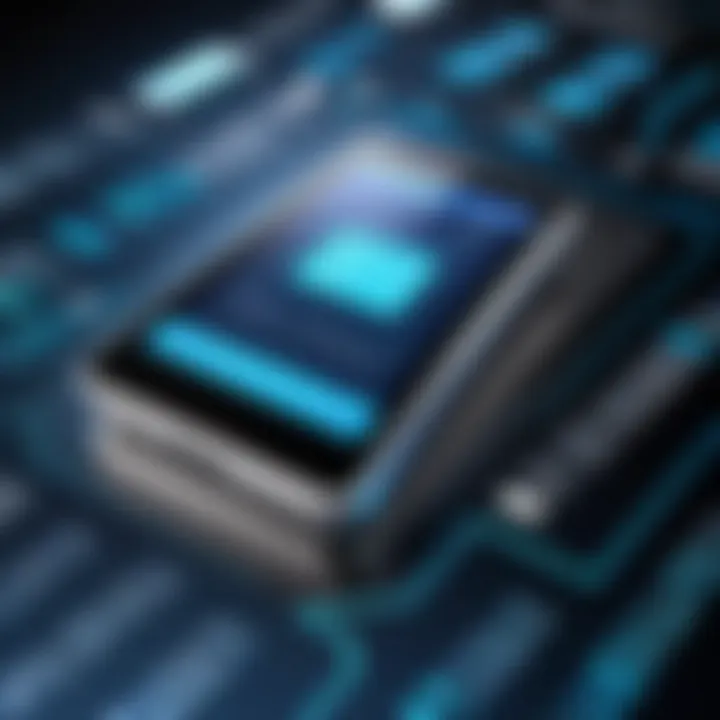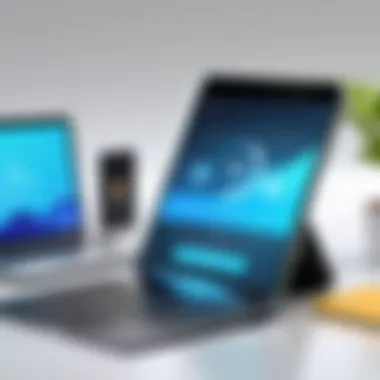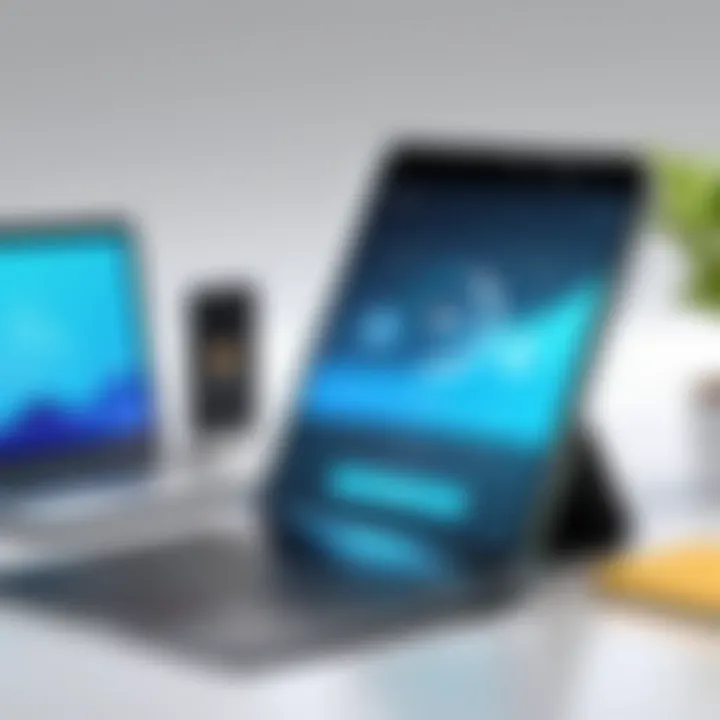The Evolution and Utility of Mobile Computing


Intro
In a world where everyone is perpetually on the go, mobile computing has emerged as a crucial component of daily life. Forget about bulky desktop computers; we have come to rely on portable devices that fit snugly in our pockets, enabling access to information and tools from virtually anywhere. The evolution from clunky laptops to sleek smartphones illustrates more than just technological advancement; it signifies a shift in how we interact with our environment, work, and socialize. This article dives into the journey of mobile computing, exploring its diverse forms, the latest technological advancements, and the implications on our professional and personal lives.
Technology Insights
Mobile computing has not only changed personal habits but has also reshaped industries. The way we perceive technology these days is intertwined with these portable devices that keep us connected and productive. Here, we will dive deeper into the latest trends, innovations, and noteworthy products that epitomize this movement.
Latest Tech Trends
- 5G Connectivity: With the introduction of 5G, the landscape of mobile computing has transformed. This technology promises significantly faster data transfer speeds, enabling seamless streaming, quick downloads, and uninterrupted online meetings.
- Foldable Devices: Devices like the Samsung Galaxy Z Fold and Huawei Mate X have redefined what we expect from mobile screens. These foldable smartphones offer the portability of a phone and the screen real estate of a tablet, catering to a hybrid user experience.
Innovation in Tech
Innovations aren't limited to hardware. Software advancements have also significantly enhanced mobile computing. Applications are increasingly becoming sophisticated, allowing for intricate tasks like video editing and complex data analysis on the go. Apple’s iPad Pro, for instance, combined with the right apps, can serve as a powerful alternative to traditional laptops.
Product Reviews
When we talk about standout products, one can’t overlook the Apple iPhone 15, boasting advanced camera systems and AI integration that echoes the needs of modern users. It’s sleek, lightweight, and versatile, making it a forerunner in mobile technology. On the Android front, the Google Pixel 8 has caught attention with its exceptional computational photography and intuitive interface, ensuring users always capture the moment perfectly.
"Mobile computing is not just about being able to work anywhere; it is about changing the way we approach our tasks and enrich our lives."
Industry Spotlights
While mobile computing is rooted in technology, its impact reverberates across various sectors, enhancing productivity and collaboration. Let’s take a closer look at how experts view this evolution.
Interviews with Tech Experts
Engaging with thought leaders in the tech community reveals fascinating insights about the future of mobile computing. According to Dr. Karen Hughes, a prominent figure in mobile technology research, the next big leap involves artificial intelligence integrated directly into mobile devices, making them smarter and more adaptable to user needs.
Closure
As we continue to explore the evolution of mobile computing, it’s clear that the future holds infinite possibilities. As technology advances, the world can expect even more innovative solutions tailored to our increasing demands for connectivity, productivity, and seamless experiences. Mobile devices are no longer a luxury; they are an integral part of life, intertwining with our daily activities and shaping how we interact with the world.
Prolusion to Mobile Computing
In today’s fast-paced world, mobile computing has become as essential as the air we breathe. The ability to compute while being on the move is not just a convenience, but a necessity in professional and personal spheres alike. Mobile computing encompasses a range of portable devices that enable users to perform computer-like tasks wherever they are. This section sheds light on the significance of mobile computing, uncovering its foundational elements, key benefits, and essential considerations.
Defining Mobile Computing
Mobile computing refers to the use of portable computing devices, which allow data computing, communication, and interaction in various contexts outside the traditionally fixed environment of a desk. Devices such as laptops, tablets, smartphones, and wearables are pivotal.
The essence of mobile computing lies within its core capabilities:
- Data access on-the-go: Users can retrieve, send, and manipulate data from virtually anywhere.
- Connectivity: Seamless internet access provided by Wi-Fi, LTE, or 5G networks enhances communication and operational efficiency.
- User-friendly interfaces: Modern operating systems are designed to be intuitive, ensuring users can navigate and utilize functionalities with minimal learning curve.
In a nutshell, mobile computing fuses technology with agility, offering a new paradigm for how we interact with information.
Historical Context
To truly grasp the impact of mobile computing today, it is crucial to understand its roots. The journey began as early as the 1980s when the first portable computers emerged. These early machines were bulky and barely scrapped the surface of mobility. However, they ignited interest in the potential for computing beyond the confines of an office.
Fast forward to the 1990s,PDAs (Personal Digital Assistants), like the Palm Pilot, were on the rise. While these devices were limited in functionality, they laid the groundwork for future innovations by placing computing power directly in consumers' pockets.
The true game-changer arrived with smartphones in the 2000s. The introduction of the iPhone in 2007 revolutionized the landscape, bringing computing to fingertips. This era also saw advancements in battery technology and connectivity that transformed how we work, communicate, and entertain ourselves.
"Mobile computing is not simply about devices; it’s about redefining where and how we operate"


As we now sit at the cusp of further innovations with wearable technology and IoT devices, it’s easy to see how the evolution of mobile computing has unfolded into a significant facet of daily life, shaping not just individual experiences but the fabric of society. The continuous development ensures that staying connected—regardless of location—is now the norm, rather than the exception.
Categories of Portable Computing Devices
In today’s fast-paced world, the categories of portable computing devices serve as fundamental pillars in both personal and professional realms. These devices not only make life more manageable but also enhance connectivity and productivity to an unprecedented degree. Characterizing devices such as laptops, tablets, smartphones, and wearables lays the groundwork for understanding their roles in our daily experiences. Each type comes with its own set of capabilities and limitations, tailoring to different needs and lifestyles.
Laptops: The Classic Mobile Computer
Laptops have long been the hallmark of mobile computing. They combine the power of traditional desktops with portability. This versatility allows users to handle intense tasks, whether it’s programming, graphic design, or comprehensive data analysis. The beauty of laptops lies in their adaptability. Users can easily move from the office to a cafe, taking their work with them.
Considerations when using laptops include size, weight, and battery life. High-performance models may come with bulkier builds, which might hinder true mobility. However, advancements in engineering have given rise to lighter models, like the Dell XPS series and Apple's MacBook Air, offering robust performance without compromising portability.
In essence, laptops have a timeless appeal, balancing functionality and flexibility, making them popular among professionals and students alike.
Tablets: A Versatile Alternative
Tablets emerge as a formidable alternative in the realm of portable devices. Often praised for their touch interface, these devices offer a unique blend of portability and functionality, bridging the gap between laptops and smartphones. For the casual user, tablets like the Microsoft Surface or Apple iPad Pro provide ample computing power for tasks such as web browsing, e-book reading, and streaming video.
What's intriguing about tablets is their inherent versatility. They can transform into full-fledged workstations with the right accessories, such as keyboards or styluses. For those involved in creative fields, using a tablet offers a natural way to express ideas through drawing or note-taking.
However, they do pose certain limits. Multitasking isn’t as seamless as on traditional laptops, and some users might find their performance insufficient for complex applications. Still, within their intended scope, tablets offer remarkable convenience and a user-friendly experience.
Smartphones: A Computing Powerhouse
No discussion of portable devices is complete without mentioning smartphones. These pocket-sized wonders have evolved into computing powerhouses, capable of performing a range of tasks that were once exclusive to larger machines. Today’s smartphones, like the Samsung Galaxy S series or the iPhone, pack ample processing power, high-resolution cameras, and extensive app ecosystems.
The impact of smartphones on everyday tasks cannot be understated. From managing schedules and communicating seamlessly to accessing vast information at a moment’s notice, they have woven themselves into the very fabric of daily life. With emerging technologies such as 5G, the potential for mobile applications continues to expand.
However, while smartphones excel at providing information and connectivity, usability concerns often arise when tackling more intensive tasks like editing large documents or programming. Their smaller screens can lead to user fatigue during extended usage. Ultimately, they serve as a handy supplemental tool amidst the portable device landscape.
Wearable Devices: Computing Reimagined
Moving beyond phones and laptops, wearable devices represent a novel approach to computing. Devices like smartwatches and fitness trackers, such as the Apple Watch or Fitbit, have carved their niche. They not only perform routine functions like notifications and health tracking but are evolving into mini-computers on the wrist.
Wearables highlight a significant shift in how we interact with technology. Their convenience allows users to stay connected without constantly pulling out their phones. Imagine biking or jogging while keeping track of messages and health metrics without breaking your stride.
Yet, the wearables space is not without challenges. Users often demand longer battery life and improved functionalities. While strides have been made, finding a balance between power and convenience remains a work in progress.
Technological Advancements in Mobile Computing
The realm of mobile computing has undergone a remarkable transformation, driven chiefly by technological advancements. Each leap forward has profoundly enhanced how we interact with devices and access data. The importance of staying current with these changes cannot be over emphasized. As devices evolve, so do the demands on performance, longevity, and connectivity. By understanding these advancements, tech-savvy individuals can better navigate the rapidly changing landscape.
Processing Power and Performance
When discussing mobile devices, processing power stands out as a key factor. Early mobile computers were often slowed down by limited processing capabilities, which hampered productivity. Today, processors such as Apple's M1 chip and Qualcomm's Snapdragon series offer performance levels that rival traditional desktops.
- The enhancement in multicore processing allows for smoother multitasking.
- Compact chips with advanced architectures ensure efficiency, providing more power while consuming less energy.
Rather than being mere calculators in our pockets, modern smartphones and tablets have become capable of running complex applications, from high-end games to professional software. Thus, the relationship between performance and battery efficiency has become a significant consideration for manufacturers.
Battery Life Innovations
Battery life has always been a sticking point in mobile computing. Users often find themselves tethered to a power outlet because their devices can’t keep up with demanding applications. Fortunately, innovations have emerged that considerably extend battery life.
New lithium-ion technologies and advancements in energy-efficient processing have made a marked difference. For instance:
- Fast charging capabilities now mean that a few minutes of charge can provide hours of use.
- New power management techniques in operating systems are fine-tuning how much battery each app consumes.


Mobile users can now rely on devices that last longer, making them more dependable during travel or extended work sessions without constantly searching for a charger.
Connectivity Enhancements
In the world of mobile computing, connectivity is the backbone that allows users to tap into cloud services, stream multimedia content, and collaborate with others in real time. The development of 4G LTE and now 5G technology represents a seismic shift in how we experience the internet on the go.
- 5G technology offers unprecedented speeds and lower latency, enabling near-instantaneous uploads and downloads. This performance facilitates advanced applications like augmented reality and real-time data processing.
- Wi-Fi advancements, too, with standards like Wi-Fi 6, have increased bandwidth and reduced congestion, benefiting users in busy environments.
These enhancements in connectivity aren’t merely technical; they fundamentally change user experiences, allowing for seamless transitions between various devices and formats, fostering a world where productivity knows no boundaries.
In the competitive arena of mobile technology, adaptation to advancements can no longer be optional; it is essential for utilizing the full potential of portable devices.
Technological advancements in mobile computing illuminate a path toward a future where reliability, efficiency, and user experience are paramount. As this field continues to evolve, staying informed on these cutting-edge innovations is crucial.
Benefits of Mobile Computing
Mobile computing has fundamentally transformed the way we interact with technology, enabling us to access information and accomplish tasks on the go. This section delves into the various benefits that mobile computing brings to individuals and organizations alike, emphasizing its relevance in today’s fast-paced world.
Increased Productivity
When you think about productivity, the picture that often comes to mind is a bustling office environment, where professionals are tethered to their desks. However, mobile computing has flipped this concept on its head.
Imagine this: a sales professional, laptop in hand, is meeting with clients in a bustling coffee shop. Thanks to mobile computing, they can access their sales data, make real-time updates, and even present in-depth reports on the spot, all without being glued to a desktop.
- Real-time Access: With portable devices, professionals have the ability to access critical applications and files at any moment. This reduces downtime and increases the efficiency of time spent outside the office.
- Task Management on the Fly: Modern mobile applications, such as Trello or Asana, enable users to keep track of their tasks, collaborate with team members, and manage projects seamlessly, regardless of their physical location.
- Enhanced Collaboration: The ability to communicate instantly through various platforms, such as Slack or Microsoft Teams, bridges the gap between remote locations, ensuring that teams stay connected and productive.
Flexibility and Remote Work
Flexibility is a word that has gained significance, especially in light of recent global shifts towards remote work. Mobile computing plays a pivotal role here, as it caters to the dynamic needs of today’s workforce.
- Home, Coffee Shop, or Anywhere: Mobile devices empower employees to work from virtually anywhere, thus contributing to higher job satisfaction. Employees can design work environments that best suit their productivity needs, whether that means working from home or a favorite café.
- Work-Life Balance: Employees no longer need to adhere to a strict 9 to 5 regime. With mobile computing, work can fit seamlessly into personal schedules, which leads to improved morale and wellness. The flexibility to attend a child’s event while also completing a report can create a harmonious balance that enhances overall job performance.
Access to Information Anywhere
One of the standout features of mobile computing is the capacity to tap into vast amounts of information at a moment’s notice.
"In the age of information, if you can't access it, you can fall behind."
- Instant Data Retrieval: Whether you’re on a crowded train or waiting in line at the supermarket, mobile devices allow users to access resources, perform research, and stay updated instantly. This immediacy ensures that critical decisions are informed and timely.
- Global Reach: With the rise of cloud computing, data is no longer confined to a single location. Users can access files and applications stored remotely, leading to an interconnected ecosystem where information flows freely, facilitating global collaboration.
Challenges Facing Mobile Computing
In the rapidly evolving landscape of mobile computing, while the benefits are plentiful, it does carry a fair share of challenges. Addressing these issues is crucial as they not only affect the advancements of mobile technology but also the user experience and security. From maintaining privacy to navigating a fragmented market, these challenges lay the groundwork for the realities that users face every day.
Security Concerns
When it comes to mobile devices, security concerns are at the forefront. Each time that a smartphone or tablet is used for online transactions or sensitive communications, there exists a risk of data breaches. Hackers are constantly on the prowl, using sophisticated methods to exploit vulnerabilities. For example, phishing attacks as well as malware targeting mobile devices have dramatically increased.
To mitigate these risks, several strategies can be adopted:
- Use of Strong Passwords: Regularly updating passwords and using complex ones can thwart unauthorized access.
- Two-Factor Authentication: Adding an extra layer of security for accounts can go a long way.
- Regular Software Updates: Keeping operating systems up to date ensures that known vulnerabilities are patched.
"Mobile security is a moving target. What works today may not work tomorrow."
The trust that consumers put in their devices hinges on how well manufacturers and software developers tackle these issues. As a result, ongoing education about security measures and risks should be emphasized.
Device Fragmentation


Another major hurdle is device fragmentation. The word may seem technical, but essentially it refers to the diversity of devices users operate. From different screen sizes to varying operating systems, the ecosystem is anything but standardized. For app developers and service providers, this can lead to a convoluted guessing game where they must tailor experiences for multiple platforms.
Consider the impact on consumers:
- Inconsistent User Experiences: An app that performs flawlessly on one device may crash on another.
- Higher Development Costs: Developers often need to create different versions of the same application to cater to various devices.
- Delayed Updates: With so many devices to account for, updates can come in waves, leading to insecurity in features and performance.
Taking steps to address this fragmentation is essential. Unified standards and frameworks can encourage smoother operations across diverse hardware, promoting a seamless computing experience for every user.
User Experience Limitations
Finally, user experience limitations present another challenge for mobile computing's future. Despite the advances in hardware and software, users can encounter frustrations. Common complaints include:
- Battery Drain: Demands of applications can lead to rapid battery consumption.
- Slow Performance: As apps become more complex, older devices struggle to keep pace, affecting usability.
- Screen Size Constraints: Editing documents or viewing detailed data on a small screen can be cumbersome, leading to inefficiencies.
In light of these issues, addressing user experience requires a holistic approach. Innovations should focus on optimizing for battery efficiency, enhancing app responsiveness, and developing intuitive interfaces that accommodate smaller screens without sacrificing functionality. This can turn potential pain points into strengths, allowing mobile computing to flourish.
As the technology advances, recognizing and remedying these challenges is vital. Success in mobile computing relies on understanding not only how to progress with technology but also how to navigate the complexities that come with it.
The Future of Mobile Computing
The future of mobile computing stands at a pivotal juncture, capable of reshaping how we interact with the world around us. As advancements in technology coalesce with societal needs, the way we think about computing devices fundamentally shifts. No longer tethered to a desk, these portable units promise not just convenience but a transformative way of life, enabling tasks previously thought impractical on the go.
In this section, we shall delve into several key components that will dictate the trajectory of mobile computing, emphasizing trends, the role of artificial intelligence, and the impending impact of 5G technology.
Trends in Technology
The tech landscape is perpetually in flux, and mobile computing is no exception. Presently, there are a handful of trends capturing attention:
- Augmented Reality (AR) and Virtual Reality (VR): Devices are becoming more capable of overlaying digital information onto the physical world. Think of real estate agents using AR to showcase properties or retail stores allowing customers to visualize products in their home environment before purchasing.
- Foldable Devices: The flexibility offered by foldable smartphones and tablets presents new possibilities for user experience. As manufacturers like Samsung and Huawei invest heavily in this technology, we could see an era where screen size adjusts seamlessly to our needs.
- Enhanced Battery Technology: Long gone are the days when a battery life extension meant just a few extra hours. With developments in solid-state batteries and energy-saving technologies, future devices may not only last longer but also charge significantly faster.
This cocktail of advancements promises to enhance multitasking capabilities and improve the overall portability of devices, allowing users to juggle work and leisure effortlessly.
The Role of Artificial Intelligence
While technology is evolving at breakneck speed, artificial intelligence is a driving force reshaping mobile computing. Context aware computing is steering us toward a more personalized experience. Imagine your smartphone predicting your needs based on time of day or location—giving you reminders, suggesting routes to avoid traffic, or even automatically setting your devices to a preferred mode for work or downtime.
Moreover, AI powers voice assistants like Siri, Google Assistant, and Alexa, transforming how we interact with our devices. These advancements don’t just make tasks easier; they shift how we think about computers. With the ability to understand nuances in language, AI is breaking down barriers and making technology more intuitive.
"Innovation in mobile AI technologies will soon make interactions with devices so seamless that the line between man and machine will blur."
The Impact of 5G Technology
As we step into an era dominated by 5G, mobile computing is set to reach new heights. 5G isn’t merely a speed game; it introduces a fundamental shift in capacity and connection. The reduction in latency allows users to host high-definition video calls practically lag-free, making remote work and teleconferencing far more effective.
Additionally, 5G opens the door for an interconnected ecosystem, where devices communicate with each other more efficiently than ever before. Self-driving cars, smart homes, and integrated health solutions will rely heavily on this technology. The potential applications seem endless, from near-instant downloads to seamless smart city integrations, culminating in a life where computing is practically invisible and omnipresent.
Closure: Embracing a Mobile Future
In every technological juncture, the essence of progress has been to enhance human connectivity and efficiency. Mobile computing is no exception. The importance of this topic highlights how deeply integrated portable devices have become in our lives. From how we work to how we interact with the world, mobile devices are the lifeblood of modern communication. Their evolution reflects not merely a change in technology, but a shift in societal norms and expectations.
Reflecting on Mobile Integration
As we look around, it’s clear that integration is the theme of the day. Mobile devices have seamlessly merged with everyday activities. Consider the way that smartphones have incorporated functionality that once belonged solely to dedicated gadgets. One device can now serve as a camera, navigation system, and personal organizer. This merging of functions not only presents convenience but transforms how we approach daily tasks.
Moreover, businesses and organizations have leveraged this integration, creating apps that streamline operations and enhance employee productivity. Subscription services and cloud storage, like Google Drive and Dropbox, allow users to access files on the go, providing the flexibility that modern work demands. In essence, mobile integration is not just an advance in technology; it is a fundamental change in how we perceive and engage with the world.
The Continuation of Innovation
Innovation in mobile computing is a relentless, driving force that reflects our insatiable appetite for efficiency and connectivity. Looking ahead, it’s vital to understand that this journey is far from over. Companies continually refine hardware and software, creating devices that are faster, lighter, and more capable.
- Artificial Intelligence is set to play a pivotal role. Imagine smartphones that can predict what you need before you even ask. Voice-enabled assistants are taking strides towards becoming more intuitive, interpreting user commands with greater accuracy.
- Augmented Reality is another arena where innovation is exploding. The likes of Pokémon GO have shown us what’s possible. As AR becomes more integrated into mobile applications, the lines between digital and physical realities are going to blur even more.
- And let’s not ignore 5G technology. With its potential to drastically improve data speeds and reduce latency, mobile computing will reach new heights.
The road ahead promises not merely linear growth but exponential leaps in capabilities. The next decade will witness developments that may seem straight out of a sci-fi novel today; we will likely see entirely new paradigms of interaction and experience.
"Mobile computing isn’t just about devices; it’s about the way we live, work, and connect with one another."







